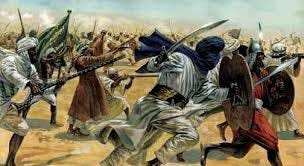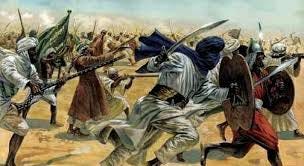The Zanj Rebellion (869–883) – The Forgotten African Revolt That Shook an Empire
Black History Through the Lens of Liberation
How Enslaved Africans in the Middle East Fought for Freedom and Built Their Own Societies
When we talk about slave revolts, the focus is often on the Americas, but centuries before the transatlantic slave trade, enslaved Africans in the Middle East launched one of the most successful and sustained uprisings in history—the Zanj Rebellion (869–883 CE).
This was not just a rebellion—it was a full-scale war that lasted 14 years, challenged one of the most powerful empires in the world, and led to the creation of an independent Black-led state in what is now southern Iraq.
The Zanj Rebellion is proof that Black resistance to slavery is a global phenomenon, and our history of revolution is deeper than the Americas alone.
Who Were the Zanj?
The Zanj were enslaved East Africans, primarily from the Swahili Coast (modern-day Tanzania, Kenya, and Mozambique), who were taken by Arab traders and forced to work in brutal conditions in Iraq, Persia, and across the Middle East.
They worked in salt marshes near Basra (Iraq), enduring extreme heat and backbreaking labor.
They were forced into sugarcane plantations, mines, and military service, making them one of the largest enslaved labor forces of the time.
They were stripped of their names, cultures, and autonomy, much like those enslaved centuries later in the Americas.
However, African people had a long tradition of resistance, and the Zanj refused to accept their fate.
How the Rebellion Began
📜 In 869 CE, a leader emerged—Ali ibn Muhammad, a revolutionary who promised the Zanj freedom, dignity, and self-governance.
📜 He organized a coalition of enslaved Africans, poor Arabs, and Persians, uniting them under a single cause: to overthrow the Abbasid Caliphate (one of the most powerful Islamic empires).
📜 The Zanj seized weapons, burned slave plantations, and recruited thousands of fighters, quickly forming a powerful army.
A Black-Led State in the Middle East
The rebellion wasn’t just about escape—it was about creating an alternative society.
The Zanj captured key cities, including Basra, a major trade hub.
They established their own government, distributing land and wealth among the formerly enslaved.
They ruled for over a decade, defeating multiple Abbasid armies sent to crush them.
For nearly 14 years, the Zanj maintained their independence, proving that enslaved Africans were not passive victims but organizers, strategists, and revolutionaries.
How the Rebellion Was Suppressed
The Abbasid Caliphate (a Muslim empire that lasted from 750 to 1258 CE) embarrassed by their losses, launched a full-scale war against the Zanj.
They sent waves of soldiers, numbering in the tens of thousands, to crush the rebellion.
They cut off supply lines and waged brutal sieges against Zanj-controlled territories.
Ali ibn Muhammad was eventually killed, and the rebellion was brutally suppressed in 883 CE.
The Abbasids massacred thousands of rebels, but they never erased the legacy of the Zanj Rebellion.
Why the Zanj Rebellion Still Matters Today
1. Black Resistance Is a Global Story
The fight for Black freedom didn’t begin with the transatlantic slave trade. The Zanj Rebellion proves that enslaved Africans resisted oppression wherever they were taken—from the Swahili Coast to the Americas.
2. It Challenges the Myth That Islam Was Free from Slavery
While Islam provided legal protections for enslaved people, the Zanj Rebellion reveals that the Arab world had its own brutal systems of forced labor and exploitation.
Muslim societies engaged in the East African slave trade for centuries, a reality often ignored in global discussions on slavery.
The rebellion reminds us that Black liberation movements have existed in every empire, not just European ones.
3. The Zanj Created a Black-Led Society in the Middle East
For nearly 14 years, formerly enslaved Africans ruled their own land, organized their own economy, and fought off imperial forces. This was one of the first Black revolutionary states in recorded history.
Reflection Question: What lessons can today’s liberation movements learn from the Zanj in terms of organization, resilience, and coalition-building?
How the Zanj Rebellion Connects to Modern Movements
📌 Mass incarceration and prison labor in the U.S. → Like the Zanj, modern incarcerated people are forced into exploitative labor, while activists fight to end the system.
📌 African migration and displacement → Just as East Africans were taken as laborers across the Middle East, today’s African migrants continue to face discrimination and exploitation.
📌 Revolts against racial capitalism → The Zanj weren’t just escaping—they were creating new economic and political models that challenged empire and class oppression.
Reflection Question: In what ways do modern systems of labor exploitation still rely on controlling Black and marginalized workers?
Resources for Further Learning
📖 Article: Race and Slavery in the Middle East (1994) by Bernard Lewis – Explores the history of slavery in Muslim societies.
🎬 Video: The Zanj Rebellion and Black Revolt in the Islamic World – A breakdown of the rebellion’s impact.
A 28-Day Journey Through Black Resistance and Liberation
The Zanj Rebellion is just one of many stories of Black revolution included in my 28-Day Journey Through Black Resistance and Liberation.
📖 Join the journey today:
🔗 Get the guide here.
The fight for freedom is older than the United States, older than the transatlantic slave trade—and it continues today.
In solidarity and liberation,
Desireé B. Stephens CPS-P
Educator | Counselor | Community Builder
Founder, Make Shi(f)t Happen




